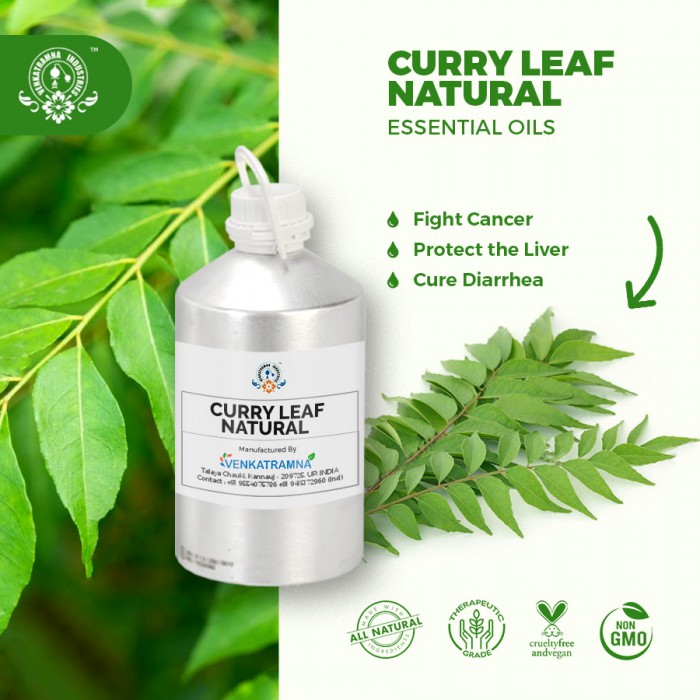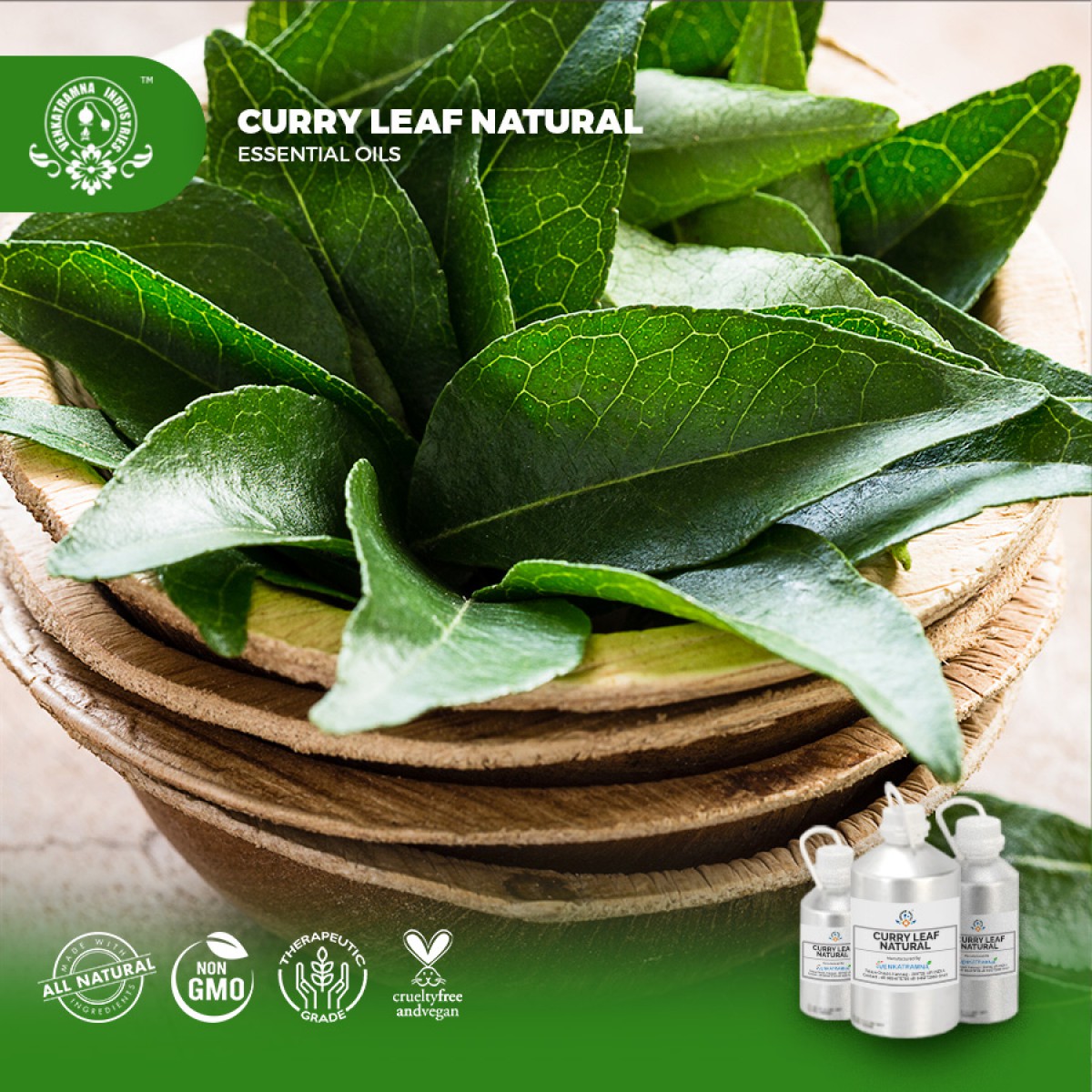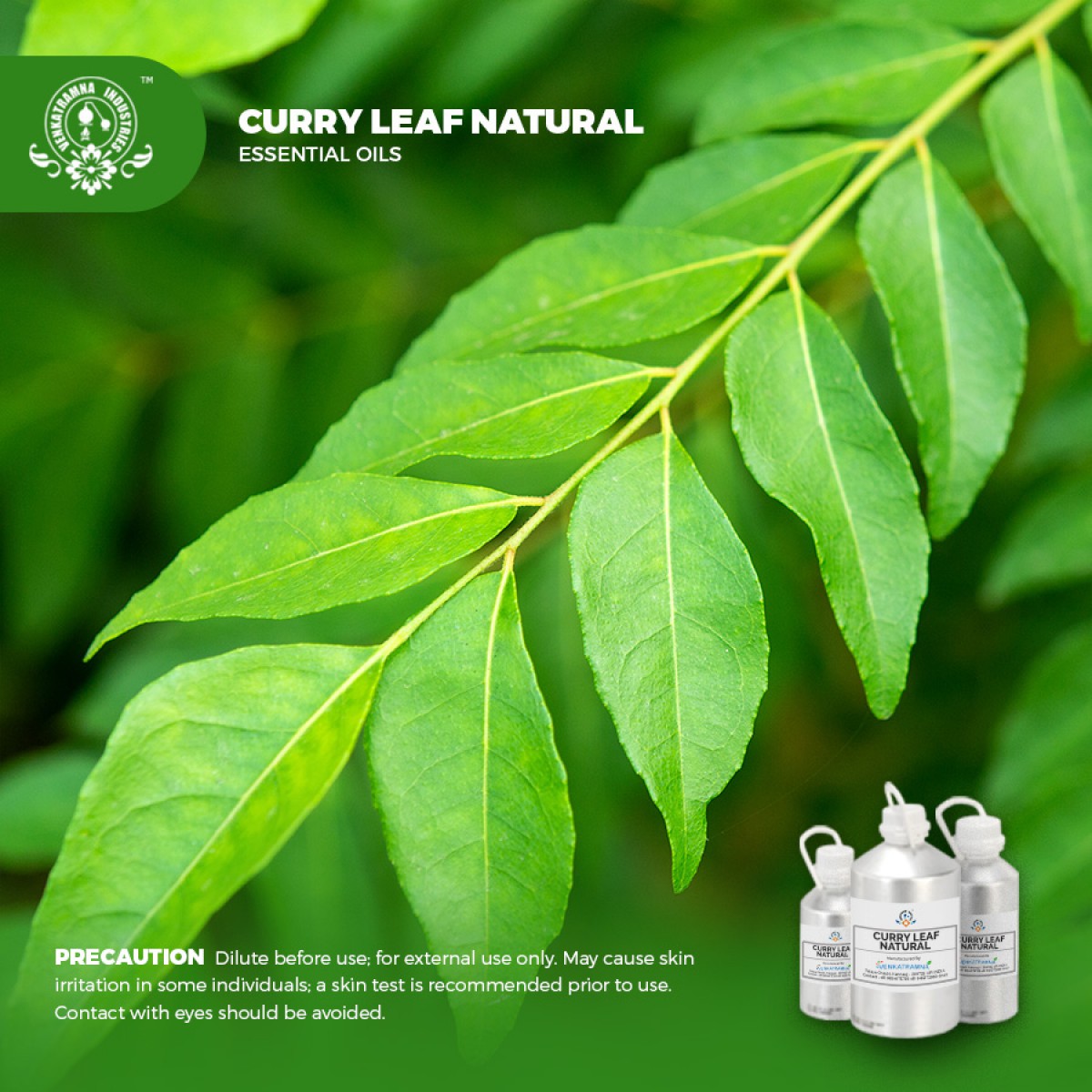Botanical Name: Murraya koenigii (L.) spreng. Common name: Curry Leaves, Read More
|
Botanical Name: |
Murraya koenigii (L.) spreng. |
|
Common name: |
Curry Leaves, |
|
Plant family: |
Rutaceae |
|
Genus: |
Murraya |
|
Appearance/Color: |
A thin colourless to pale yellow |
|
Odor: |
Clear liquid with sweet and spicy, with a bitter tone
characteristic. |
|
Blends With: |
Basil, Nutmeg and Rose. |
|
Origin: |
India |
Murraya koenigii has
diverse role in traditional medicine and is known for its stomachic
properties. The leaves and roots in
different forms have great therapeutic potential and is used for the treatment
of night blindness, dysentery, diarrhoea, vomiting, bites of poisonous animals,
bruises and eruption. Leaves are often used in curries for flavouring and
seasoning due to their aromatic nature. They are generally called by the name
"curry leaves" and are an important export commodity from India and
fetches good foreign revenue. The plant is a rich source of carbazole
alkaloids. Phytocompounds like koenimbine, koenine, mahanimbine,
murrayazolidine, murrayazoline, murrayacine, girinimbine, mukoeic acid, etc.
have also been isolated and characterized. These bioactive compounds possess
antioxidant, antimicrobial, anthelmintic, analgesic, anti-inflammatory,
antidiarrheal, hepatoprotective and antitumor properties.
Murraya koenigii is a native of India, Sri Lanka and other south Asian countries. Murraya koenigii is distributed throughout India and is abundantly found from Sikkim to Garhwal, Bengal, Assam, Western Ghats and Kerala. It reached to Malaysia, South Africa and Reunion Island from India along with South Indian immigrants. Murraya koenigii is more or less deciduous shrub or small tree reaching up to 6 m in height. The plant has a short trunk with 15-40 cm diameter, smooth, greyish or brown bark and has dense shady crown. The main stem is dark green to brownish in colour. The leaves are bipinnately compound, 15-30 cm long, each bearing 11-25 leaflets alternate on rachis, 2.5-3.5 cm long ovate lanceolate with an oblique base. The leaf margins are irregularly serrate and petiole is 2-3 mm long. Inflorescence is terminal cymes; each bearing 60-90 flowers. Each flower is bisexual, white, funnel shaped sweetly scented, stalked, complete, ebracteate and regular with average diameter of fully opened flower being 1.12 cm. The calyx is deeply lobed with five cleft and pubescent. Petals are five with free, whitish, glabrous dotted glands. Fruits occur in close clusters. They are small ovoid or subglobose, glandular, with thin pericarp enclosing one or two seeds which are spinach green in colour.
DISCLAIMER
The complete range of conditions
or methods of use are beyond our control therefore we do not assume any
responsibility and expressly disclaim any liability for any use of this
product. Information contained herein is believed to be true and accurate however,
all statements or suggestions are made without warranty, expressed or implied,
regarding accuracy of the information, the hazards connected with the use of
the material or the results to be obtained from the use thereof. Compliance
with all applicable federal, state, and local laws and local regulations
remains the responsibility of the user.
The FDA has not evaluated the
statements on this website. No claims are made by Venkatramna Industries as to
the medicinal value of any products from vriaroma.com or by us. The information
presented here is for educating our customers about the traditional uses of
essential oils and is not intended to diagnose, treat, cure, or prevent any
disease. You are responsible for understanding the safe application of these products.
If you have any questions, please call or email us for further information.
As per NAHA guidelines, New Directions Aromatics
(NDA) does not recommend the ingestion of essential oils. It is imperative to
consult a medical practitioner before using Essential Oils for therapeutic
purposes. Pregnant and nursing women and those taking prescription drugs are
especially advised not to use this product without the medical advice of a
physician. The oil should always be stored in an area that is inaccessible to
children, especially those under the age of 7.
Murraya koenigii is one of
the plant species with potential medicinal properties. The whole plant and
different parts of the plant are used to cure many human ailments.
Curry Leaf Oil in Pharma
The oil is mainly used as
stimulant, antidysenteric, anti-periodic, antiemetics, antidiarrheal, blood
purifier, tonic, antifungal, depressant, anti-inflammatory. It can also be used
to cure body aches, kidney pain, vomiting, stomachic, leucoderma, febrifuge,
diabetes mellitus, besides promoting appetite and digestion. Carotenoids,
carbazole alkaloids, coumarin, carbazole carboxylic acid, lipids and essential
oil are the dominant phytoconstituents of the plant.
Essence of Curry Leaf Oil
Murraya koenigii (L.) Spreng or its common name curry
leaf tree is a small strong smelling perennial shrub commonly found in forests
as undergrowth. It was originally cultivated in India for its aromatic leaves
and for ornament is normally used for natural flavoring in curries and sauces. The
aromatic leaves, which retains their flavor and other qualities even after
drying, are slightly bitter, acrid, cooling, weakly acidic in tastes and are
considered as a tonic, anthelmintic, analgesic, digestive, appetizing and are
widely used in Indian cookery for flavoring food stuffs
COMMON USAGE
·
Cure diarrhea
·
Gastrointestinal protection
·
Antioxidant properties
·
Anti-diabetic properties
·
Fight cancer
·
Lower cholesterol levels
·
Good for hair growth
·
Radioprotective and chemo-protective
·
Protect against pathogen attack
·
Protect the liver
·
Skin care
Ingredients:
|
S.No |
Key Constituents |
Strength (%) |
|
1 |
b-phellandrene |
24.4 |
|
2 |
a-pinene |
17.5 |
|
3 |
b-caryophyllene |
7.3 |
|
4 |
Terplene-4-ol |
6.1 |
|
5 |
(P)-limonene |
5.1 |
|
6 |
g-terpinene |
4.9 |
|
7 |
a-phellandrene |
4.8 |
|
8 |
sabinene |
4.1 |
|
9 |
b-pinene |
3.7 |
|
10 |
a-terpinene |
2.8 |
|
11 |
b-myrcene |
2.3 |
|
12 |
(E)-b-ocimene |
1.8 |
|
13 |
a-terpineol |
1.6 |
|
14 |
a-thujene |
1.6 |
|
15 |
a-sellnene |
1.1 |
|
16 |
Terpinolene |
1.1 |
|
17 |
p-cymene |
1.0 |
|
18 |
b-phellandrene |
24.4 |
|
19 |
a-pinene |
17.5 |
|
20 |
b-caryophyllene |
7.3 |
TOXICOLOGICAL
INFORMATION
Safety Summary
·
Hazards: skin sensitization if oxidized.
·
Cautions: Old or oxidized oils should be
avoided.
Safety advice
Because of its high combined
a-pinene and (þ)-limonene content it is recommended that oxidation of cypress
oil is avoided by storage in a dark, airtight container in a refrigerator. The
addition of an antioxidant to preparations containing it is recommended.
Organ-specific effects
Adverse skin reactions: No information found for curry leaf oil or b-phellandrene.
Autoxidation products of a-pinene and (þ)- limonene can cause skin
sensitization.
Systemic Effects
·
Acute toxicity: No information found for curry
leaf oil or b-phellandrene.
·
Carcinogenic/ anticarcinogenic potential: A
Malaysian curry leaf oil with 19.5% b-caryophyllene and 15.2% a-caryophyllene
showed a dose-dependent antitumoral action against MCF-7 human breast cancer
cells in vitro.
·
Skin corrosion/irritation: May cause sensitization by skin
contact.
·
Serious eye damage/irritation: Spray and vapor in the eyes may cause
irritation and smarting.
·
Respiratory sensitization: In high concentrations, vapors may
irritate throat and respiratory system and cause coughing.
·
Reproductive toxicity: Not specified
·
STOT-single exposure: Not specified
·
STOT-related exposure: Not specified s
·
Interactive effects Not specified
·
Aspiration Hazard: No Data Available
ECOLOGICAL
INFORMATION
·
Toxicity:
No Additional Data Available.
·
Results of PBT and vPvB assessment
o
PBT: Not applicable.
o
vPvB: Not applicable.
·
Persistence and degradability No further
relevant information available.
·
Bio-accumulative potential No further relevant
information available.
·
Mobility in soil No further relevant information
available.





 MSDS-Curry_leaf.pdf
MSDS-Curry_leaf.pdf




